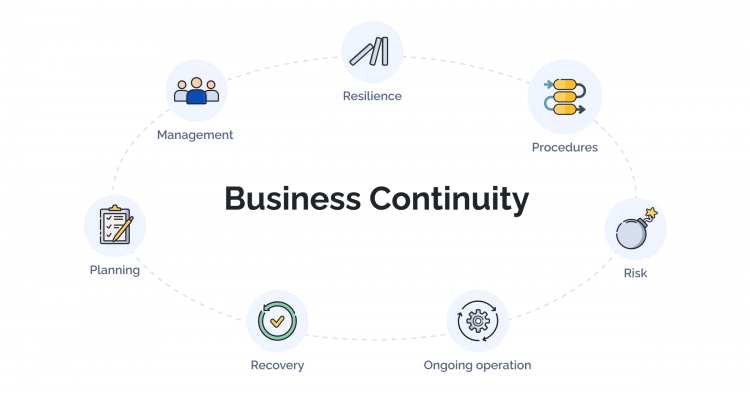Business Continuity is an approximate attribution of a company’s survivability in the event of a disaster or any other threat, along with its consequences. Malware attacks, natural or technological disasters, local failures, or supply chain problems can all cause massive damage measured in wasted time, money, and reputation. So, we can call business continuity a set of components that help companies to stay operational in different situations.
Hence a business continuity plan is a complex of a company’s actions and instructions that make sure a company survives any disaster. It determines all those unexpected and unpredictable situations that can happen to an organization and all the required steps and actions to take during and after those situations.
For any company it will be more than beneficial to have a decent business continuity strategy. Ironically, it would be a challenge for many companies to create, continuously improve, and, most importantly, use business continuity strategies. Many specialists agree that preparation of continuity and recovery plans for any company first requires analyzing and learning their operation process to set a level of cruciality for each operation process/department component. From that moment onwards, the company can focus on improving the components with the highest level in the first place.
Why is Business Continuity Important?
The company faces a cyber-attack, a fire or a hurricane that destroyed a data center, key employees are lost due to unexpected circumstances. Those are just a couple of examples of situations that a company could face during its operation. Each situation could cause a certain level of damage, resulting in dire financial repercussions and financial losses. If a business wants to survive under any circumstances, it is important to analyze all those potential situations, their probability, and plan how to deal with them. The continuous analysis and planning process will improve the overall company’s experience (department cooperation and coordination, structuring of the production cycle/operational cycle, etc). Sometimes, business continuity is a crucial requirement to stay competitive.
What does Business Continuity include?
When working on a business continuity strategy, a preventative and structural manner of work should be considered as a primary approach. To make sure that the company survives with minimal or zero damage to its operation process, the plan should consist of the following:
- Structural and clear guidance for each potential situation with respective actions for each case: list of actions needed, contact information, and guidance documentation describing each action (starting with when to use documentation).
- Prioritizing the recovery process. The company goes from the most to least important part of the operational process, avoiding or decreasing the damage and saving resources.
- The business continuity process covers the entire company. It is crucial to have clear and effective communication between departments and management layers. The information should be easily transferred inside the organization to coordinate and change the process. The most critical part is collaboration between the departments like security and IT.
Key Elements of Business Continuity Plan
An effective plan contains three key components, namely resilience, recovery, and contingency.
Resilience can be improved by building the core operation processes around the idea of potential threats. For example, there could be spare hardware for quick maintenance, permutable personnel, etc. Business resiliency allows the company to have a seamless reaction process for each separate incident.
A fast and seamless process is what recovery should be all about. Recovering the most important components of the business process first is vital to bring the damage from incidents as close to zero as possible. Additionally, cooperation with others allows delegating some processes to free up resources to cover other areas.
The contingency plan is “Plan B,” a set of actions taken to deal with the incident. It usually includes activity inside and outside of the company. Replacing the failed hardware is an example of an inside action, and cooperation with another company qualifies as an outside action.
How to Implement a Business Continuity Plan?
Creating an effective business continuity plan takes a lot of time and effort. At the same time, it is a vital part of an organization’s capacity to survive. The starting point is to gather the team of specialists working on the initial plan and continuously improving it. This team will create all the documentation and instructions with all the info about each step, all the responsible people, how to contact them, communication, etc.
When ready, the team is supposed to analyze operational process components to find vulnerabilities in each element of the workflow. The analysis will further enable the organization to determine core components of the operational process, their weak spots, and eventually prioritize each element in terms of recovery. The next step should be analyzing each vulnerability separately and understanding its potential damage to understand what the counter action should be and how quickly it should be performed to minimize the damage.
And finally, the company must test everything and simulate the event to see how it goes in case of an actual emergency. Everything can sound perfect in theory, but practice shows that even the most elaborate plans may require adjusting. That is why testing is as important as planning: it shows where the plan fails and how to improve it.
Business Continuity Management
When an incident occurs, somebody should have been appointed to control the execution of the business continuity plan. Depending on its size, the company can delegate the entire process to a single person or create a separate work team. Business continuity software could be of help in automating and simplifying everything. The person or team responsible continuously improves the plan by training employees, performing simulations, analyzing the results with the company’s top management, and adding adjustments based on said results.
Business Continuity Tools
Any such plan should not only rely on the specialists that execute it but also on tools that help to do it faster and smoother. There is a wide range to choose from:
- Back-up. Creating backup infrastructure and backing up all types of data is the first and easiest way to achieve a certain level of business continuity. It is possible to build personal backup infrastructure or contract another company that provides that type of data protection service.
- Recovery sites. Building an identical twin of its primary office in another location is also an option. That location will have everything to continue the operational process. Depending on the plan, the recovery site could be “on-hold” and must be prepared before the company can continue the operation. On the other hand, recovery sites can be running in parallel with the main ones and have everything ready to go. In the event of a disaster, all that needs to be done is to quickly switch to it and continue working.
- Disaster Recovery as a Service (DRaaS). DRaaS is some sort of golden middle between backups and recovery sites. It implies contracting another company that provides its resources as a service. The service provider will put a virtual copy of the contractor’s entire computer processing to its cloud infrastructure. In the event of a disaster, the contractor can simply switch to its resource’s virtual copy and continue its business.
- Virtualization. The same as DRaaS, only without the involvement of another party. The company creates virtual copies of its employees’ working machines on the server equipment on-premises or off-site. It is supposed to be in check all the time to keep the data up to date in the company’s virtual infrastructure.
- Recovery equipment. The equipment for reducing the damage of specific types of accidents. This type of equipment deals specifically with physical damage to a company’s property.
Business Continuity with StarWind Solutions
StarWind Software can provide various products that support businesses in surviving disasters:
- StarWind Virtual SAN software. A Software Defined Storage solution that allows real-time data replication between the servers. It is amazingly easy to configure, has shallow requirements, and is hardware agnostic. That results in company’s flexibility upon choosing the hardware. Its replication allows surviving through hardware failures and accessing production data. StarWind VSAN also supports different configurations and allows putting servers in different buildings or locations, which helps the company survive disasters and minimize the damage.
- StarWind HCI Appliance. The combination of all the features and capabilities of StarWind VSAN software and reliable hardware provides businesses with an all-in-one solution. It is to be used for different purposes. Being an all-in-one, this StarWind product frees up quite some time to concentrate on more important things – time that otherwise would have been spent searching for all those components. Its ProActive support feature provides that delegation of resources that could be used for other purposes with a dedicated support team monitoring the health of the production cluster.
- StarWind Backup Appliance. As the name suggests, it assists with data backup. In tandem with the backup software, it becomes a solution that can backup up the data, store it, and recover in a case of failure. Additionally, StarWind Backup Appliance can be a temporary point of restoration for the data and VMs to continue the operational process. Supporting different configurations can save the company’s data from different accidents.
- StarWind Virtual Tape Library Appliance. This storage solution complements features of typical server flexibility in hardware configuration with the functionality of a physical tape library. StarWind VTLA basically emulates a physical tape library on top of the regular server. The result provides storage performance capabilities of the server drives with the safety features of a physical tape library. In addition, it can replicate data to the cloud providing organizations with an additional safe copy of the data to be used in the event of a complete disaster.
Business Continuity vs Disaster Recovery
Business continuity and disaster recovery are remarkably similar in their nature, but they focus on distinct aspects of the workflow:
| Differential aspects | Business Continuity | Disaster Recovery |
| Management priorities | Focus is surviving the accident and trying to minimize operational interruptions. | Focus on minimizing the number of system failures and the speed of the system’s recovery. |
| Scope of action | Includes all the elements that allow the company to stay operational. | Prioritizing IT systems and data storage in most cases. |
| Execution | Top management determines that an accident is indeed happening. | Initiates after early steps of business continuity as a post-accident respective action. |
FAQ
What are the Business Continuity standards?
Business continuity standards ensure consistency while adopting a specific methodology. Following the guidelines and prescribed procedures also gives organizations the luxury of quick turnaround.
The concept broadly encompasses the following aspects:
- Quickly establishing resource requirements for restoring operations as well as keeping them running.
- Prioritizing recovery procedures based on the criticality of operations.
- Protecting employees, resources, and assets from legal scrutiny by providing valid evidence of preventive, response, and restoration measures.
- Designing plans at the organizational level to be integrated across organizations for leveraging a consolidated response as and when required.
What is Business Continuity Institute?
It is an organization that creates and shares business continuity standards and best practices for companies to help them on their path of developing their business continuity plans.
What are the benefits of Business Continuity implementation?
Proper business continuity planning gives a company considerable chance of surviving different accidents. The probability level entirely depends on how good the planning process was. Some of the results of successful planning are:
- The company receives a ton of information about the parts of its operational process to improve the plan and the operational process.
- Deep knowledge of the operational process and its weaknesses allows taking preventive actions and changing some processes to work better and suffer less damage during accidents. Simultaneously, the company can plan actions to take during the incident to minimize the impact of it.
- With all the information about its processes, communications between departments, and weaknesses it becomes possible to improve the overall quality of services and products.



